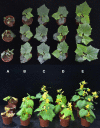Evaluation and Genome Analysis of Bacillus subtilis YB-04 as a Potential Biocontrol Agent Against Fusarium Wilt and Growth Promotion Agent of Cucumber
- PMID: 35756052
- PMCID: PMC9218633
- DOI: 10.3389/fmicb.2022.885430
Evaluation and Genome Analysis of Bacillus subtilis YB-04 as a Potential Biocontrol Agent Against Fusarium Wilt and Growth Promotion Agent of Cucumber
Abstract
Cucumber wilt caused by Fusarium oxysporum f.sp. cucumerinum (Foc) is a highly destructive disease that leads to reduced yield in cucumbers. In this study, strain YB-04 was isolated from wheat straw and identified as Bacillus subtilis. It displayed strong antagonistic activity against F. oxysporum f.sp. cucumerinum in dual culture and exhibited significant biocontrol of cucumber Fusarium wilt with a higher control effect than those of previously reported Bacillus strains and displayed pronounced growth promotion of cucumber seedlings. B. subtilis YB-04 could secrete extracellular protease, amylase, cellulose, and β-1,3-glucanase and be able to produce siderophores and indole acetic acid. Inoculation with B. subtilis YB-04 or Foc increased cucumber defense-related enzyme activities for PPO, SOD, CAT, PAL, and LOX. However, the greatest increase was with the combination of B. subtilis YB-04 and Foc. Sequencing the genome of B. subtilis YB-04 showed that it had genes for the biosynthesis of various secondary metabolites, carbohydrate-active enzymes, and assimilation of nitrogen, phosphorous, and potassium. B. subtilis YB-04 appears to be a promising biological control agent against the Fusarium wilt of cucumber and promotes cucumber growth by genomic, physiological, and phenotypic analysis.
Keywords: Bacillus subitilis; Fusarium oxysporum f.sp. cucumerinum; biocontrol agent; genome sequencing and assembly; growth promotion.
Copyright © 2022 Xu, Yang, Yang, Xie, Goodwin, Deng, Tian and Yang.
Conflict of interest statement
The authors declare that the research was conducted in the absence of any commercial or financial relationships that could be construed as a potential conflict of interest.
Figures







Similar articles
-
Mechanism of a novel Bacillus subtilis JNF2 in suppressing Fusarium oxysporum f. sp. cucumerium and enhancing cucumber growth.Front Microbiol. 2024 Nov 13;15:1459906. doi: 10.3389/fmicb.2024.1459906. eCollection 2024. Front Microbiol. 2024. PMID: 39606119 Free PMC article.
-
Genome sequencing and analysis of Bacillus velezensis VJH504 reveal biocontrol mechanism against cucumber Fusarium wilt.Front Microbiol. 2023 Oct 12;14:1279695. doi: 10.3389/fmicb.2023.1279695. eCollection 2023. Front Microbiol. 2023. PMID: 37901818 Free PMC article.
-
Genomic and Phenotypic Insights into the Potential of Bacillus subtilis YB-15 Isolated from Rhizosphere to Biocontrol against Crown Rot and Promote Growth of Wheat.Biology (Basel). 2022 May 20;11(5):778. doi: 10.3390/biology11050778. Biology (Basel). 2022. PMID: 35625506 Free PMC article.
-
Influence of Bacillus subtilis strain Z-14 on microbial ecology of cucumber rhizospheric vermiculite infested with fusarium oxysporum f. sp. cucumerinum.Pestic Biochem Physiol. 2024 May;201:105875. doi: 10.1016/j.pestbp.2024.105875. Epub 2024 Mar 18. Pestic Biochem Physiol. 2024. PMID: 38685217
-
Bacterial endophytome-mediated resistance in banana for the management of Fusarium wilt.3 Biotech. 2021 Jun;11(6):267. doi: 10.1007/s13205-021-02833-5. Epub 2021 May 15. 3 Biotech. 2021. PMID: 34017673 Free PMC article. Review.
Cited by
-
Exploring the Potential of Bacillus subtilis IS1 and B. amyloliquificiens IS6 to Manage Salinity Stress and Fusarium Wilt Disease in Tomato Plants by Induced Physiological Responses.Microorganisms. 2024 Oct 19;12(10):2092. doi: 10.3390/microorganisms12102092. Microorganisms. 2024. PMID: 39458401 Free PMC article.
-
The Research of Antagonistic Endophytic Bacterium Bacillus velezensis CSUFT-BV4 for Growth Promotion and Induction of Resistance to Anthracnose in Camellia oleifera.Microorganisms. 2024 Apr 10;12(4):763. doi: 10.3390/microorganisms12040763. Microorganisms. 2024. PMID: 38674707 Free PMC article.
-
Bacillus-based biocontrol beyond chemical control in central Africa: the challenge of turning myth into reality.Front Plant Sci. 2024 Feb 6;15:1349357. doi: 10.3389/fpls.2024.1349357. eCollection 2024. Front Plant Sci. 2024. PMID: 38379944 Free PMC article. Review.
-
The biocontrol potentials of rhizospheric bacterium Bacillus velezensis K0T24 against mulberry bacterial wilt disease.Arch Microbiol. 2024 Apr 15;206(5):213. doi: 10.1007/s00203-024-03935-3. Arch Microbiol. 2024. PMID: 38616201
-
Two Bacillus spp. Strains Improve the Structure and Diversity of the Rhizosphere Soil Microbial Community of Lilium brownii var. viridulum.Microorganisms. 2023 May 6;11(5):1229. doi: 10.3390/microorganisms11051229. Microorganisms. 2023. PMID: 37317201 Free PMC article.
References
-
- Al-Naamani L. S. H., Dobretsov S., Al-Sabahi J., Soussi B. (2015). Identification and characterization of two amylase producing bacteria Cellulosimicrobium sp. and Demequina sp. isolated from marine organisms. J. Agricult. Mar. Sci. 20 8–15. 10.24200/jams.vol20iss0pp8-15 - DOI
-
- Banani H., Spadaro D., Zhang D., Matic S., Garibaldi A., Gullino M. L. (2015). Postharvest application of a novel chitinase cloned from Metschnikowia fructicola and overexpressed in Pichia pastoris to control brown rot of peaches. Int. J. Food Microbiol. 199 54–61. 10.1016/j.ijfoodmicro.2015.01.002 - DOI - PubMed
LinkOut - more resources
Full Text Sources
Miscellaneous

